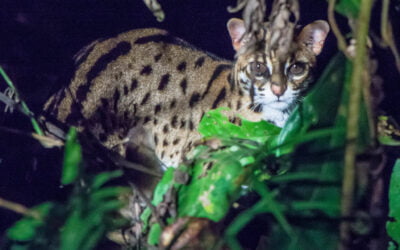Physical description of Andean Mountain Cats
The Andean mountain cat is a medium-sized cat but looks larger due to its thick fur, especially on its back. It is cold at altitude, and the fur traps air to maintain their body temperature. The body length is usually just over half a meter, and the tail is nearly as long again.
The fur is light grey or silvery and has brownish spots that seem to blend into one another. Their underside is generally lighter colored with darker spots. A spotted pattern which appears to lead to stripes features more prominently on the legs and tail.
Its coloring is somewhat similar to the pampas cat, which has an overlapping range. However, the Andean cat has a lighter grey underlying color compared to its golden brown cousin. Comparatively, the stripe patterns are distinctive from one another.
Distribution and habitat of Andean Cats
Andean Mountain Cats, as their name suggests, live in the South American mountains of the same name. However, they don’t live along the full length of the continent. Their range spans from Northern Chile and Argentina through into Southern Peru and Bolivia.
Their predisposition to mountain rodents for prey is probably due to the limitation of their habitat. Or they acquired a taste for mountain chinchillas as they were already living within a confined range.
Who knows why the cats ended up amidst a harsh habitat, but it certainly is adept. Whilst they live at high altitudes, above 3000 m and above the forest line in typically arid scrubland, the Andean cat is also found in areas of high-altitude meadows.
Andean Mountain Cat behavior
All cats are great hunters, but some specialize more than others. It seems that the Andean mountain cat is proficient in preying upon the mountain chinchillas in the high Andes. They are agile hunters, which is a necessity for the rocky mountainous terrain in which they live.
They hunt primarily at night but are known to be active during the day. In fact, their desolate and remote homelands have distanced them from people, whereby they lack caution or fear of humans, and daytime sightings of this nocturnal animal are relatively common.

What do Andean Mountain Cats eat?
The Andean cat will eat anything it can find in its high altitude range. Lizards or rodents are on the menu, as are birds and rabbits. However, as aforementioned, its’ meal preference is the mountain Chinchilla
Mating and Parental care of Andean Mountain Cats
We know little about the Andean mountain cats’ reproductive behavior or how they care for their kittens. Should we assume that they share the characteristic traits of other cats? Many cat species have similarities, and it is quite likely they live and breed like their close cousin, the pampas cat.
More detailed research and observations are required to evidence definitive differences or similarities with other species.
Andean Mountain Cats and their ecosystem
The cat most likely keeps small rodent populations under control.
Impact of Andean Mountain Cats on the human economy
Hunting of the Andean mountain cat is not common. They are sometimes hunted for their pelts, but it isn’t a significant threat to their survival.
Given the remoteness of the cats’ habitat, human activity is not threatened. Livestock or poultry to prey upon is absent in their habitat range. Given their stature, hunting livestock would be a stretch.
Conservation status and human impact on Andean Mountain Cats
The Andean cat is fully protected, as estimates put their population below 2500. It is ranked as endangered by the IUCN Red List.
Explanations for its low numbers aren’t precise. However, extensive hunting of Chinchillas has led to a decrease of their preferred prey. This has led to a general decline in numbers along with hunting and habitat degradation.
Historical beliefs may have induced local populations to kill the cats as they were considered to be bad luck.
Other important information about Andean Mountain Cats
The Andean mountain cat is one of the least known and least observed cats. Even the more common pampas cat has not been studied thoroughly.










